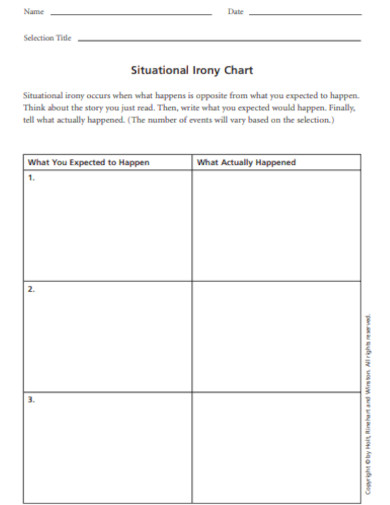6+ Situational Irony Examples to Download
Life is full of surprises. We all like to believe in a world of fairytales and happy endings, but the real world, along with the works of fate, always has other plans for us. This type of action or event is referred to as irony. Irony teaches us that not everything is what it seems. We could expect one thing to happen, but something completely opposite may take place. For kids to get a better understanding of irony, there is also irony for kids. You may also see examples of sarcasm.
Situational and Verbal Irony Template
Sample Situational Irony Template
Printable Situational Irony Example
Situational Irony Chart Example
Draft Situational Irony Example
Situational Irony Literary Analysis
Situational Irony Example Template
Developmental Trends in Situational Irony
Specific Situational Irony Example
Company Situational Irony Example
Analysis of Situational Irony Example
Situational Irony Assignment Template
What Is Situational Irony?
The situational irony comes to play when an audience expects one thing, but an entirely different outcome transpires. Irony also helps make their narratives seem more realistic in the eyes of an individual. For instance, no matter how much we plan something out, there’s always a chance of things going the opposite direction. Situational irony simply portrays situations that are surprising yet relatable to the complexities of real life.
How to Write Situational Irony
How to write a good situational irony. We know that situational ironies occur as a means to contrast what is expected and what is happening depending on the situation. For writers to write a good situational irony in their stories, speeches, or even essay writing, all they need to do is to follow the steps written below.
Step 1: Make Your Expectations Clear and with a Twist
The way to start with your situational irony is to make your intentions clear. But it is also expected and necessary to introduce your expectations and reality with a twist. Establishing a clear expectation for your audiences to expect what they believe will happen, and the twist that will contradict what they were expecting. More like a turn of events.
Step 2: Build up the Tension
Apart from making your expectations clear in a situational irony and introducing a twist to it, you should also build some tension to help heighten the impact of it. Building tensions in your stories will help direct the audience or the readers to the right directions. It helps anticipate and leading to the twist. You should also think about playing with perspectives. Highlighting the different perspectives will be helpful.
Step 3: Add in a Little Humor
Adding a little humor is fine. However, adding too much humor may make the impact of the twist in situational ironies lost in translations. Be careful not to overdo it.
Step 4: Show It Don’t Tell It
The best way to use situational irony is to show it in your stories. Not just to tell it in plain sight. As it is difficult for some of your readers to determine that this is already a situational irony than something else. Showing it helps by describing a vivid picture to your readers.
FAQs
What is the difference with situational irony, verbal irony, and dramatic irony?
Situational irony plays a distinctive role in literature. It occurs when an action or event garners the opposite result from what was expected from it. Not only does it emphasize important scenes in a story, but it also adds a creative twist that could either result in a comic or tragic end in a plot. Like dramatic irony and verbal irony, situational irony creates a bridge between fiction and reality for a given audience to enjoy. It is one of the many literary tools and rhetorical devices used to turn a dull piece of writing into something extraordinary.
What are examples of situational irony in literature?
Situational irony occurs when the final outcome of a story or scene contradicts the expectations made by an audience. This appears in movies, novels, and other forms of literature, as a good plot twist is what makes things all the more interesting. While situational irony is quite common in different genres, it is most prevalent in thrillers and mysteries. Stories like Romeo and Juliet, Hamlet, and Macbeth.
Why is it important to use situational irony in stories?
Using situational ironies in stories is an effective tool used as a means to engage audience or their readers. It is also a way to convey messages for them that can have a huge impact on their lives.
Irony teaches us that not everything is what it seems. We could expect one thing to happen, but something completely opposite may take place. But irony can also be a broad topic to take on, which is why it is categorized into three types: verbal, dramatic, and situational. You may also see personification examples.














